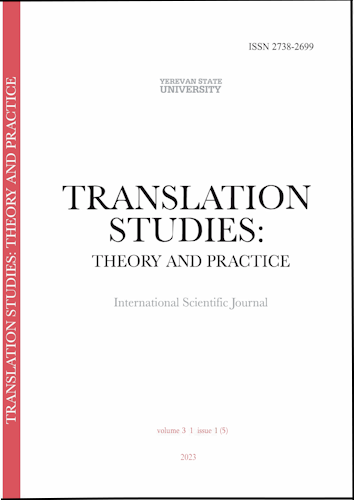Lettera in Proverbi by Antonio Vignali: Paremiological Study
DOI:
https://doi.org/10.46991/TSTP/2023.3.1.094Keywords:
Antonio Vignali, Sixteenth century, Letters, ParemiasAbstract
In the volume entitled Las cartas en refranes en España en el siglo XVI: Blasco de Garay (Sardelli, in press) we approach the study of letters in sayings in the Spanish literary tradition of the 16th century, with special attention to the work of Blasco de Garay, the maximum representative of this genre that combines the epistolary model and the use-abuse of sayings. In the same tradition, some Italian works of the 16th century seem to have been conceived with the same intention of playing with the proverb, so that the paremiological element becomes the very skeleton of an epistle which, deprived of this sententious charge, also loses all possible meaning.
In this work, we will devote ourselves to the paremiological analysis of an exemplary letter of this peculiar genre, the Lettera in proverbi by Antonio Vignali, which contains more than 300 sententious statements and phraseological units. After classifying the paremias found, we will analyse the methodology of their insertion in the text and their function in the economy of the letter.
References
Barsanti Vigo, Mª Jesús (2008): “Los refranes en El Quijote. Estudio lingüístico y literario”, [Los refranes y El Quijote Los refranes y El Quijote]. Atenas: Editorial Ta kalós keímena. Serie El Jardín de las Hespérides nº 2, pp. 49-72.
Bizarri, Hugo (2004): El refranero castellano en la Edad Media. Madrid: Ediciones del Laberinto.
Calero Vaquera, Mª Luisa (1999). “Paremiología e Historia de la Lingüística (Las paremias en la obra de Mateo Alemán)”. Paremia, 8: 85-94.
Cantera Ortiz de Urbina, Jesús; Sevilla Muñoz, Julia ; Sevilla Muñoz, Manuel (2005): Refranes y otras paremias y fraseologismos en Don Quijote de la Mancha. Vermont: Universidad de Vermont.
Fasla, Dalila (1998): “Conmutación y sinonimia en el léxico musical del refranero español del bajomedievo”. Paremia, 7, 53-60.
Flonta, Teodor (ed.) (1995): Lettera in proverbi (1557) di Antonio Vignali. [http://cogweb.ucla.edu/Discourse/Proverbs/Vignali.html].
Joly, M. (1996): Études sur Don Quichotte. Paris: Publications de la Sorbonne.
Pecori, Giampaolo (ed.) (2012?): Lettera in proverbi di Antonio Vignali. Firenze: Libreria editrice fiorentina.
Pérez Martínez, Herón (1996): El hablar lapidario. Ensayo de Paremiología mexicana. Zamora: El Colegio de Michoacán.
Sardelli, Maria Antonella (2007a): “La Zucca (1551) de Anton Francesco Doni y su versión española” [Seminario Internacional Colección Paremiológica Madrid 1922-2007]. Madrid: Biblioteca Histórica Municipal de Madrid, pp. 233-252.
Sardelli, Maria Antonella (2007b): “Las paremias en Le sottilissime astuzie di Bertoldo (1606) de Giulio Cesare Croce y su correspondencia italiana”. Paremia, 16: 117-128.
Sardelli, Maria Antonella (2009): “El elemento paremiológico en Le piacevoli e ridicolose semplicità di Bertoldino (1608) de Giulio Cesare Croce”. [L’Europa dei proverbi]. ROMA: Casa Editrice Università La Sapienza, pp. 43-64.
Sardelli, Maria Antonella (2010): “Algunas consideraciones sobre el Diálogo de la Lengua (1535) de Juan de Valdés”. [Post tenebras spero lucem. Los estudios gramaticales en la España Medieval y Renacentista]. Granada: Editorial Universidad de Granada, pp. 169-190.
Sardelli, Maria Antonella (2012). “Análisis narratológico, semiológico, temático y fraseológico de 377A, madera de héroe de Miguel Delibes”. Paremia, 21: 163-176.
Sardelli, Maria Antonella (2014): “Las paremias en una obra de Calderón de la Barca” [Fraseología y paremiología: enfoques y aplicaciones]. Biblioteca Fraseológica y paremiológica, SERIE MONOGRAFÍAS, vol. 5. MADRID: Instituto Cervantes.
Sevilla Muñoz, Julia (1993): “Las paremias españolas: clasificación, definición y correspondencia francesa”. Paremia, 2: 15-20.
Sevilla Muñoz, Julia; Crida Álvarez, Carlos (2013): “Las paremias y su clasificación”. Paremia, 22: 105-114.
Downloads
Published
How to Cite
Issue
Section
License
Copyright (c) 2023 Maria Antonella Sardelli

This work is licensed under a Creative Commons Attribution-NonCommercial 4.0 International License.










